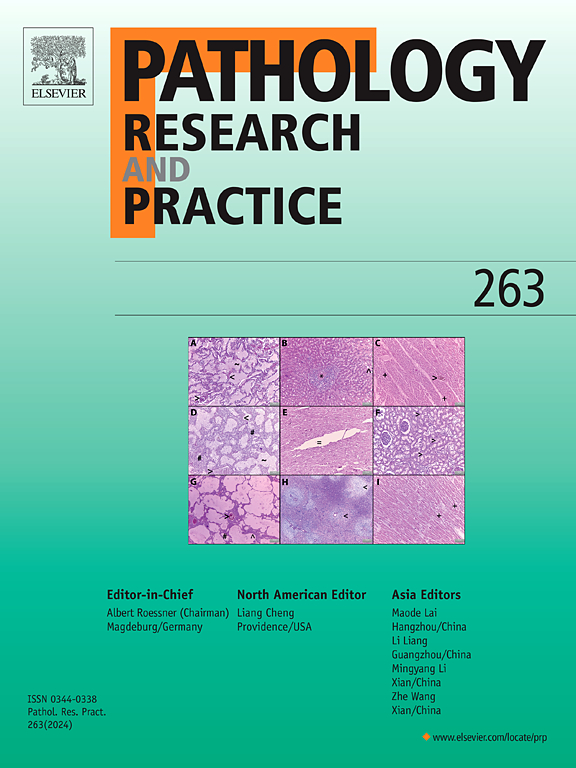Proteomic insights into lymph node metastasis in breast cancer subtypes: Key biomarkers and pathways
IF 2.9
4区 医学
Q2 PATHOLOGY
引用次数: 0
Abstract
Background
Breast cancer (BC) is a significant global cause of death in women, primarily due to its diversity and metastatic potential.
Methods
BC, healthy lymph node (HL), and metastatic lymph node (ML) tissues were collected from 19 patients diagnosed with infiltrating ductal carcinoma. Protein isolation was performed, followed by two-dimensional gel electrophoresis (2DE) and mass spectrometry (MALDI-TOF/TOF) to identify differentially expressed proteins. Bioinformatic analyses, including protein-protein interaction networks and molecular pathways, were conducted using STRING. Kaplan-Meier analysis was performed with KM plotter to evaluate the prognostic significance of identified proteins. Receiver operating characteristic (ROC) curves were generated using TCGA and GTEx data from UCSC Xena and easyROC to assess diagnostic relevance.
Results
Distinct pathways related to cytoskeletal regulation, immune modulation, and oxidative stress response were enriched in each subtype. Key proteins such as TUBA1C, CCT6A, and Vimentin (LNA), CAPZB and ENO1 (LNB), GSTO1 (HER2 OE), and CORO1A and LAP3 (TNBC) were identified as significant in driving metastatic behavior. KM survival analysis showed that CAPZB (LNB) and CORO1A (TNBC) were associated with patient outcomes, while GSTO1 was linked to improved distant metastasis-free survival in HER2 OE. ROC analysis highlighted CAPZB as a strong diagnostic marker.
Conclusions
These findings form a basis for comprehending the molecular mechanisms underlying metastasis in different subtypes of breast cancer. They may lead to the identification of new therapeutic targets for customized interventions against invasion and metastasis. Further validation is required to confirm their clinical utility in larger cohorts.
求助全文
约1分钟内获得全文
求助全文
来源期刊
CiteScore
5.00
自引率
3.60%
发文量
405
审稿时长
24 days
期刊介绍:
Pathology, Research and Practice provides accessible coverage of the most recent developments across the entire field of pathology: Reviews focus on recent progress in pathology, while Comments look at interesting current problems and at hypotheses for future developments in pathology. Original Papers present novel findings on all aspects of general, anatomic and molecular pathology. Rapid Communications inform readers on preliminary findings that may be relevant for further studies and need to be communicated quickly. Teaching Cases look at new aspects or special diagnostic problems of diseases and at case reports relevant for the pathologist''s practice.

 求助内容:
求助内容: 应助结果提醒方式:
应助结果提醒方式:


